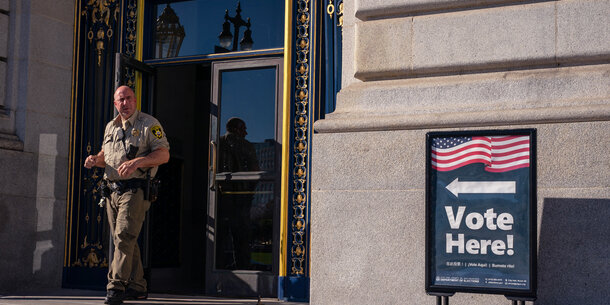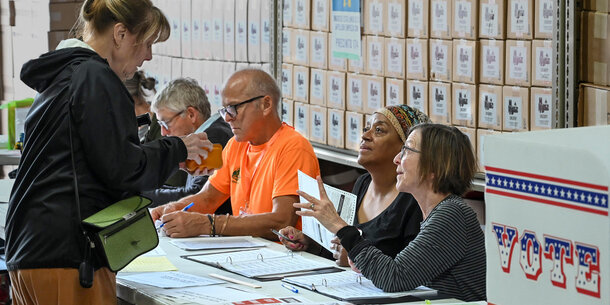Earlier this week, Jessica Huseman, the editorial director of Votebeat, published an opinion piece in the Daily Beast that — while lauding many of the goals of the For the People Act (H. R. 1/ S. 1) — raised a number of concerns about the bill, including that election officials were worried about how difficult it would be to administer.
While we agree that there are fixes that should be made to the bill, which Huseman herself noted “are doable,” we want to clarify some misimpressions that may have been left by the critique. We do not believe any of the points made in the article undermine our assessment that the For the People Act is an exceptionally important piece of legislation that can and should be passed by Congress.
Below are some important things to know about the For the People Act:
1. The Bill Authorizes Ongoing Funding
The Daily Beast article asserts that the bill fails to provide for “cashflow into the future.” It’s true that it is not an appropriations bill (nor could it be under congressional rules), but S. 1 authorizes $1 billion in appropriations for voting system improvement grants in 2021 — far more than the previous rounds of election security funding in 2018 and 2020 combined. The bill also authorizes $175 million in each of 2022, 2024, 2026, and 2028 to ensure that election officials can continue to improve election systems and cover ongoing maintenance costs of new systems. For automatic voter registration (AVR), S. 1 authorizes $500 million in funding for 2021 and additional sums in years after as may be necessary for states to meet the bill’s requirements.
2. Telephone Registration Is Not in S. 1
The Daily Beast Article criticizes “For the People Act” for mandating telephone registration. We agree that requiring states to allow registration by telephone presents administrative and security issues. While the version passed by the House would require states to make registration available “through the use of an automated telephone-based system,” this provision was fortunately not included in the Senate’s version.
3. Creating a Federal Electronic Pollbook Certification Program, as For the People Act Would Do, Is Important and Widely Supported by Officials of Both Parties
Including e-pollbooks in the definition of voting systems for the purposes of certification is an important change to address an emerging security vulnerability. Congressional Republicans and Democrats alike have supported this change, and a bipartisan group of state secretaries of state recently called on Congress to require e-pollbook certification. Thirteen states already certify e-pollbooks, demonstrating that such a program is clearly administrable. But these individual state efforts have created a patchwork of varying or conflicting standards, and far too many states do not have the resources or expertise to implement something similar.
While the U.S. Election Assistance Commission (EAC), the federal agency charged with setting federal voting system guidelines and administering federal election funds, does not currently include e-pollbooks in its voting system testing and certification program, there is no reason the agency should not be required to do so. Indeed, last year, the EAC partnered with the nonprofit Center for Internet Security to launch a pilot project to develop methods for assessing e-pollbooks and other nonvoting technology. Nor — contrary to the implication in the Daily Beast article — is there any reason to expect that federally certified testing labs are incapable of testing e-pollbooks to federal standards, merely because they do not currently do so.
4. Federally Accredited Voting System Test Laboratories Already Examine E-Pollbooks
The article expresses concern about whether federally accredited certification labs can examine e-poll books. This should not be an issue. While e-pollbooks are not yet tested to federal standards (because there are none), these labs already do test e-pollbooks to state standards — for instance, the commonwealth of Virginia has required the use of federally certified voting system test labs to conduct testing of electronic pollbooks under the state’s electronic pollbook certification program since 2015.
5. The Transition Away from Paperless Voting Machines Mandated by the Bill Is Overdue and Reasonable
Paperless voting systems are a significant security risk, and the complete transition away from these systems is long overdue. The requirement that states stop using paperless voting machines by the fall 2022 election is entirely reasonable. Only seven states still use at least some paperless voting machines, and other states have shown that moving to an all-paper system is possible in a shorter time than what is allotted in this bill. Virginia decertified paperless voting machines in September 2017 and replaced all decertified equipment by the November general election just three months later. New Jersey — one of the seven states that still uses paperless systems — implemented an entirely new paper-based all-mail election for 2020 in a matter of months.
This change can happen fast when there is an impetus or mandate to do so. The security and integrity of our elections cannot wait any longer. We need a firm deadline for when we will no longer have outdated, vulnerable voting equipment.
And unlike the states that made this change in prior election cycles, these remaining states are no longer without resources to make this transition. Congress already allocated $380 million in 2018 and $425 million in 2020 to help fund new election equipment. S. 1 would authorize another $1 billion to fund voting system improvements, with an additional $175 million each election year from 2022 to 2028. These grants can be used for a broad range of purposes that help facilitate the transition away from paperless machines, including to address concerns about paper ballot storage in any transitioning jurisdictions that are large enough to require significant adjustments to current practice.
6. EAC Responsibilities in the Bill Are Appropriate
While S. 1 does delegate additional responsibilities to the EAC, these responsibilities mostly build on things that the agency already does — distributing funding, issuing best practices, and certifying voting systems. We acknowledge that the EAC has sometimes been ineffective at meeting statutory responsibilities in the past, particularly when the agency lacked a quorum. But in the past year, the agency has brought on effective new staff leadership and facilitated some much-needed measures to improve election security and administration.
In particular, the EAC has shown that it can successfully and quickly distribute funds allocated by Congress. In the past three years, it distributed more than $1.2 billion to help states address election security needs and respond to challenges of the pandemic — and getting additional funds to states is the largest responsibility that S. 1 delegates to the agency.
While the bill gives the agency authority to decide how to distribute some of these funds based on need and past performance, it limits the likelihood of partisan gridlock or favoritism in such distribution by creating an advisory committee of experts to provide the agency with public recommendations as to where such funds should go. To the extent that Congress is uncomfortable with even limited discretion, it could ensure that supplemental funds are subject to a statutory formula.
7. The Automatic Voter Registration Timeline Includes a Waiver Provision
S.1 generally requires states to implement automatic voter registration by 2023. This timeline should be typically reasonable to meet, according to the experience of multiple states. In fact, of the states that have implemented AVR to date, six did so in less than a year from legislative enactment, and five did so in less than two years. Other states quickly adopted automatic voter registration without authorizing legislation, and several have begun but not yet completed implementation.
But even if states cannot meet this deadline, S. 1 allows states to seek a waiver and extend the effective date to 2025. While it’s true that S.1 covers state agencies beyond Departments of Motor Vehicles, Congress can extend the timeline for additional state agencies or the timelines can be addressed in court if the AVR deadline of 2025 proves to be a problem.
S.1 authorizes $500 million in funding for 2021 and additional sums as may be necessary in succeeding years. There is no reason to believe that these sums are not enough. Multiple states, including Maryland, Michigan, and Washington, implemented AVR wholly in-house, without significant additional costs. Moreover, there will be no costs for the 14 states and D.C. that already have AVR in place, and likely others that are in the process of implementing it, as they will be exempted from S. 1’s requirements.
While it is true that successful AVR requires coordination with multiple state election agencies, we agree that states can “choose to allocate funding to these offices themselves using” grants that the EAC distributes. There is no reason to believe that states cannot direct money to the right place to satisfy federal requirements. As Secretary of State Jocelyn Benson of Michigan noted in her testimony to the Senate Rules Committee, “with sufficient funding, partnerships, leadership and political will, it is entirely possible to sufficiently and successfully implement” AVR and other reforms contained in the For the People Act.
8. The Private Right of Action Isn’t So New
When federal election statutes create new rights for voters, as For the People Act does, it is common to explicitly provide a right of action for voters in statute, or for courts to imply a right of action so that individuals can go to court to protect those newly created rights. While the private right of action in S. 1 is admittedly broader than in the most recently passed election legislation, it is important to have an alternative enforcement mechanism if states refuse to implement the commonsense reforms contained in this bill and the Justice Department fails to enforce the statutory requirements.
Even with a private right of action, courts will still get to determine whether lawsuits are reasonable, and they will reject suits if statutory requirements are impossible to comply with in practice. In any event, the lack of an explicit statutory private right of action in the past has not prevented private individuals from suing state and local jurisdictions over federal election statutes or the security of their voting systems. It is not unusual for litigation to follow election administration changes, but this cannot be sufficient reason to refrain from needed changes.
If Congress would like to consider an alternative to the current language, the right of action provision can be pared back to exclude purely administrative reforms, or a safe harbor provision can be added for jurisdictions that take reasonable efforts to comply with S. 1’s voting system requirements.
9. Some Tweaks to the Bill Need to Be Made
Huseman’s Daily Beast article does raise some concerns we fully agree with.
For instance, the article raises valid concerns around the timeline for decertifying voting systems that do not comply with the latest voluntary voting system guidelines (VVSG). The Brennan Center has previously recommended that this provision be eliminated or altered. With the EAC just recently approving a new VVSG, more time is needed for voting system manufacturers to respond and develop compliant systems and for election officials to purchase and implement this new equipment.
We also agree that the recommendation in the bill that states use self-sealing envelopes can present administrative difficulties and unnecessary costs. While we understand the desire to provide self-sealing envelopes in the middle of the COVID pandemic, we do not believe this should be a permanent requirement.
As Huseman herself noted these problems are “absolutely not unfixable.” Given how important “For the People Act” is for American democracy, it is critical that this fact not be ignored. The Brennan Center (and other groups) are working closely with election officials to identify any additional fine-tuning that will ensure that this bill is as effective and administrable as possible.





